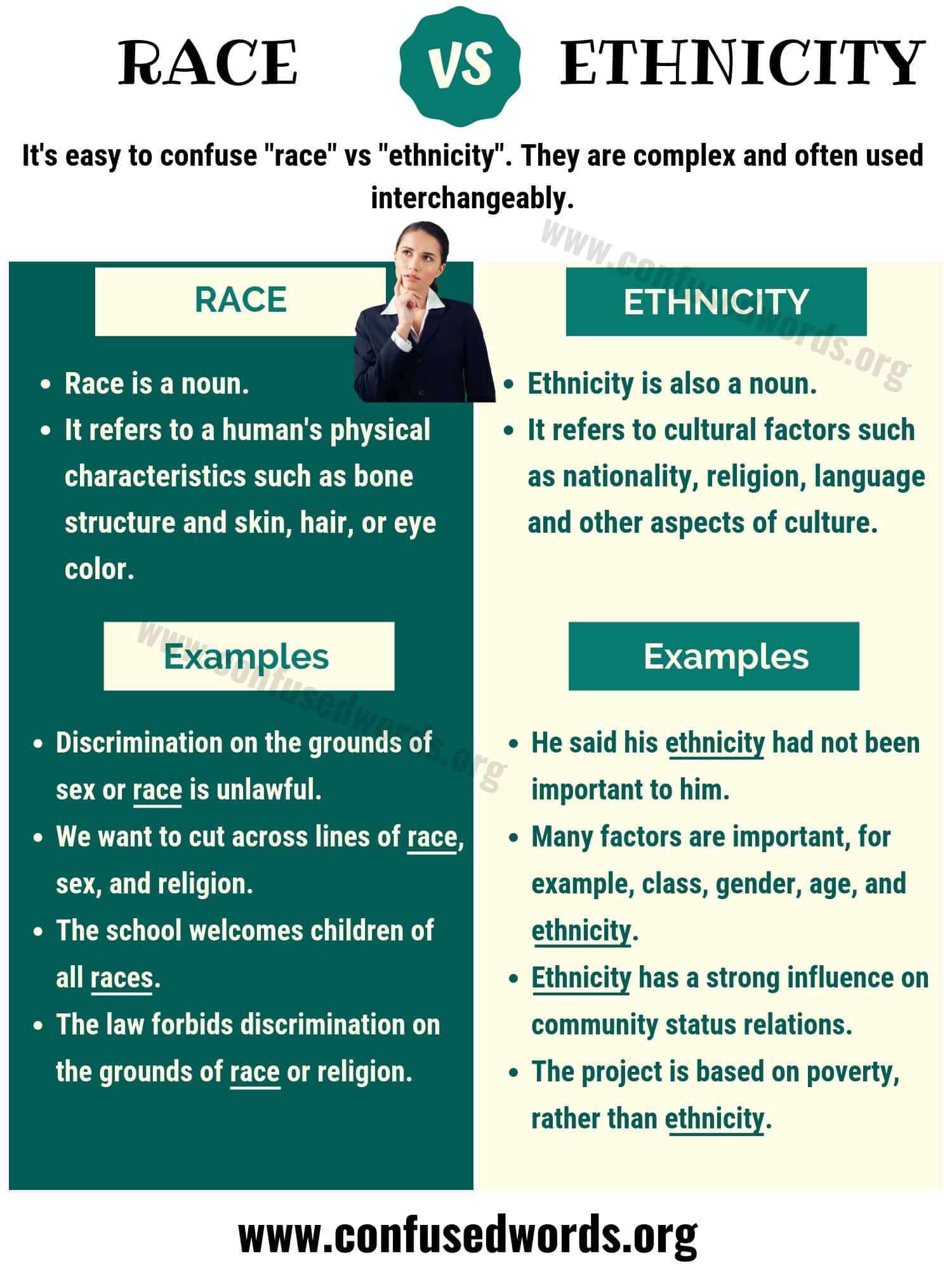Understanding Race And Ethnicity Difference: A Comprehensive Guide
Race and ethnicity difference is a topic that has intrigued scholars, policymakers, and everyday individuals for decades. At its core, these terms define how we identify ourselves and others in a diverse world. While "race" often refers to physical characteristics such as skin color, "ethnicity" delves into cultural, linguistic, and ancestral ties. Together, they shape how communities interact, how identities are formed, and how societies evolve. Understanding these distinctions is not just an academic exercise; it’s a pathway to fostering inclusivity and reducing prejudice in our interconnected world.
Despite their frequent interchangeability in casual conversations, race and ethnicity difference is far more nuanced. Race is often tied to biological factors, though modern science has debunked the idea of race as a purely genetic construct. Ethnicity, on the other hand, is rooted in shared traditions, languages, and histories. These differences influence everything from personal identity to systemic inequalities. Recognizing and respecting these distinctions can lead to more equitable societies, making it essential to explore their implications in detail.
In today’s globalized world, the conversation around race and ethnicity difference has never been more relevant. From workplace diversity initiatives to cultural representation in media, these concepts are at the forefront of societal change. By examining their origins, impacts, and intersections, we can better understand how to bridge divides and create environments where everyone feels valued. This article delves deep into the complexities of race and ethnicity difference, offering insights that are both informative and actionable.
Read also:Unlocking Success The Journey Of Smartschoolboy9
Table of Contents
- What Are Race and Ethnicity Difference?
- How Do Race and Ethnicity Difference Shape Identity?
- The Historical Roots of Race and Ethnicity Difference
- Why Is Understanding Race and Ethnicity Difference Important?
- What Are the Common Misconceptions About Race and Ethnicity Difference?
- How Can We Promote Equity Through Race and Ethnicity Awareness?
- How Do Race and Ethnicity Difference Impact Different Communities?
- Frequently Asked Questions About Race and Ethnicity Difference
What Are Race and Ethnicity Difference?
To truly grasp the concept of race and ethnicity difference, we must first define each term individually. Race is often associated with physical traits, such as skin color, hair texture, and facial features. Historically, it has been used to categorize people into groups based on perceived biological differences. However, modern science has shown that race is more of a social construct than a biological one. For example, genetic studies reveal that there is more diversity within so-called racial groups than between them.
Ethnicity, on the other hand, is rooted in shared cultural practices, traditions, and histories. It encompasses language, religion, cuisine, and even geographical origins. For instance, someone might identify as Hispanic based on their Spanish-speaking heritage, even if their physical appearance aligns with various racial categories. Ethnicity is fluid and can change over time, depending on how individuals or groups choose to identify themselves.
Key Differences Between Race and Ethnicity
- Race is primarily based on physical characteristics.
- Ethnicity is tied to cultural and ancestral connections.
- Race is often imposed by societal structures, while ethnicity is more self-defined.
Why Does This Distinction Matter?
Understanding the difference between race and ethnicity is crucial for addressing systemic issues like discrimination and inequality. For example, policies aimed at reducing racial disparities may not necessarily address ethnic inequalities, and vice versa. By recognizing these nuances, we can create more targeted and effective solutions.
How Do Race and Ethnicity Difference Shape Identity?
Identity is a complex tapestry woven from various threads, including race and ethnicity difference. For many individuals, these factors play a significant role in how they see themselves and how they are perceived by others. For example, a person of African descent might identify racially as Black while also identifying ethnically as Nigerian or Jamaican, depending on their cultural background.
These identities can influence everything from personal relationships to career opportunities. In multicultural societies, individuals often navigate multiple identities, balancing the expectations of their racial and ethnic groups with those of the broader society. This can lead to both challenges and opportunities, as people strive to maintain their cultural heritage while adapting to new environments.
Examples of Identity Formation
- A biracial individual may choose to identify with one race over another, depending on societal context.
- An immigrant might adopt the cultural norms of their new country while retaining aspects of their ethnic heritage.
How Do Societal Norms Influence Identity?
Societal norms and stereotypes often shape how individuals perceive their own race and ethnicity. For example, someone from an ethnic minority might face pressure to assimilate into the dominant culture, leading to a sense of alienation from their roots. On the other hand, embracing one’s ethnic identity can foster a sense of pride and belonging.
Read also:Unlocking The Power Of Remoteiot Vpc Raspberry Pi Free A Comprehensive Guide
The Historical Roots of Race and Ethnicity Difference
The concepts of race and ethnicity difference have deep historical roots, often tied to colonialism, slavery, and migration. During the colonial era, European powers used race as a tool to justify the exploitation of indigenous populations and the transatlantic slave trade. These systems of oppression were built on the false premise that certain races were inherently superior to others.
Ethnicity, meanwhile, has been shaped by patterns of migration and cultural exchange. For example, the African diaspora resulted in the blending of African, European, and indigenous cultures in the Americas, creating new ethnic identities. Similarly, the partition of India in 1947 led to the formation of distinct ethnic and religious groups, such as Hindus and Muslims, who were once part of a shared cultural heritage.
Impact of Historical Events on Modern Perceptions
- The legacy of slavery continues to influence racial dynamics in countries like the United States.
- Colonial borders often disregarded ethnic divisions, leading to conflicts in post-colonial states.
How Have These Histories Shaped Contemporary Issues?
Understanding the historical roots of race and ethnicity difference is essential for addressing modern challenges, such as systemic racism and ethnic conflict. By acknowledging these past injustices, societies can work toward reconciliation and healing.
Why Is Understanding Race and Ethnicity Difference Important?
In an increasingly diverse world, understanding race and ethnicity difference is more important than ever. These concepts influence everything from individual interactions to global politics. For example, businesses that prioritize diversity and inclusion often outperform their competitors, as they are better equipped to understand and serve diverse customer bases.
On a societal level, recognizing race and ethnicity difference can help reduce prejudice and promote equity. For instance, educational programs that teach students about different cultures and histories can foster empathy and understanding. Similarly, policies that address racial and ethnic disparities in areas like healthcare and education can lead to more equitable outcomes.
Benefits of Understanding These Differences
- Improved communication and collaboration in multicultural settings.
- Reduced instances of discrimination and bias.
What Are the Long-Term Implications?
By fostering a deeper understanding of race and ethnicity difference, societies can create environments where everyone has the opportunity to thrive. This not only benefits individuals but also strengthens communities and nations as a whole.
What Are the Common Misconceptions About Race and Ethnicity Difference?
Despite growing awareness, many misconceptions about race and ethnicity difference persist. One common myth is that race is a fixed and immutable category. In reality, racial classifications have shifted over time, often reflecting political and social agendas. For example, the U.S. Census has changed its racial categories multiple times, reflecting evolving societal norms.
Another misconception is that ethnicity is solely based on nationality. While nationality can be a component of ethnicity, it is not the only factor. For instance, someone from Brazil might identify ethnically as Afro-Brazilian, reflecting both their national and cultural heritage.
Why Do These Misconceptions Persist?
These misconceptions often stem from a lack of education and exposure to diverse perspectives. Media portrayals and stereotypes can also reinforce false narratives about race and ethnicity, perpetuating misunderstandings.
How Can We Address These Misconceptions?
Education is key to dispelling these myths. By teaching accurate and nuanced information about race and ethnicity, we can challenge stereotypes and promote understanding. Open dialogue and cross-cultural exchanges can also play a vital role in breaking down barriers.
How Can We Promote Equity Through Race and Ethnicity Awareness?
Promoting equity through race and ethnicity awareness requires a multifaceted approach. At the individual level, people can educate themselves about different cultures and histories, challenging their own biases and assumptions. This can lead to more inclusive behaviors and attitudes.
At the institutional level, organizations can implement policies that address racial and ethnic disparities. For example, companies can adopt diversity and inclusion initiatives, while governments can enact laws that protect against discrimination. These efforts can create environments where everyone has an equal opportunity to succeed.
Strategies for Promoting Equity
- Implementing diversity training programs in workplaces.
- Supporting minority-owned businesses and initiatives.
What Role Do Allies Play?
Allies can play a crucial role in promoting equity by amplifying marginalized voices and advocating for systemic change. By standing in solidarity with those who face discrimination, allies can help create a more just and equitable society.
How Do Race and Ethnicity Difference Impact Different Communities?
The impact of race and ethnicity difference varies across communities, depending on factors like geography, history, and socioeconomic status. For example, indigenous communities often face unique challenges related to land rights and cultural preservation, while immigrant communities may struggle with assimilation and language barriers.
These differences highlight the importance of tailored approaches to addressing racial and ethnic inequalities. For instance, policies aimed at improving educational outcomes for African American students may not address the specific needs of Latino or Asian American students. By recognizing these distinctions, we can create more effective and inclusive solutions.
Examples of Community-Specific Impacts
- Indigenous communities often experience higher rates of poverty and unemployment.
- Asian American communities may face stereotypes that mask underlying disparities.
What Are the Broader Implications?
Addressing the unique challenges faced by different communities is essential for achieving true equity. By focusing on the specific needs of each group, we can create a more inclusive and just society for all.
Frequently Asked Questions About Race and Ethnicity Difference
What Is the Difference Between Race and Ethnicity?
Race refers to physical characteristics, while ethnicity is tied to cultural and ancestral connections. Understanding this distinction is key to addressing issues of identity and inequality.
Why Is It Important to Talk About Race and Ethnicity Difference?
Talking about race and ethnicity difference fosters understanding and reduces prejudice, leading to more inclusive and equitable societies.
How Can I Educate Myself About These Topics?
Reading books, attending workshops, and engaging in open dialogue are great ways to learn about race and ethnicity difference. Websites like Teaching Tolerance offer valuable resources.
Conclusion
Understanding race and ethnicity difference is not just an academic pursuit; it’s a vital step toward creating a more inclusive and equitable world. By recognizing the nuances of these concepts, we can challenge stereotypes, address systemic inequalities, and celebrate the rich diversity that makes our world unique. As we continue to navigate the complexities of identity and belonging, let us strive to build bridges rather than walls, fostering a future
Discover The Secrets Of Tobrut Indo: A Comprehensive Guide
Who Is Shamari Fears Devoe? A Deep Dive Into The Rising Star's Journey
Exploring The Star Quarterback Future Plans: A Comprehensive Guide

Difference Between Race And Ethnicity NBKomputer

Race vs ethnicity what is the difference between them? Live Science